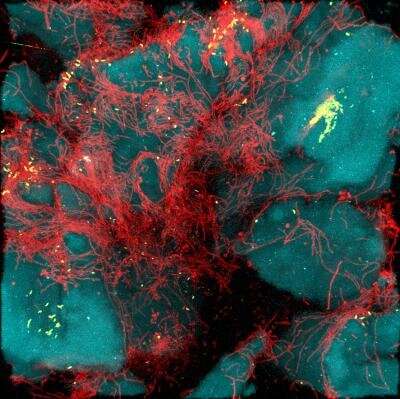Research on cholera adds to understanding of the social life of bacteria

Certain strains of cholera can change their shape in response to environmental conditions to aid their short-term survival, according to new research from Dartmouth College.
In the research, some strains of the bacterium Vibrio cholerae transformed themselves from small, comma-shaped cells to long filaments in nutrient-poor environments.
This strategy of changing cell shape supports the growth of bacterial communities and allows the pathogen to compete in environments with a quick turnover of surfaces on which to grow.
According to the study, the formation of the elongated cell shapes allows the rapid formation of communities of bacteria that bind to surfaces—known as biofilms—that are essential in turbulent nutrient environments. These formations come at the expense of being able to compete in the long term with biofilms made from smaller cells that pack together more tightly.
The finding adds to the understanding of how bacteria adapt to their environment.
"Bacteria are normally thought of as solitary organisms, but they are actually highly-social organisms that like to live in groups," said Carey Nadell, an assistant professor of biology at Dartmouth. "This research shows that we can relate cell structure to group behavior in new ways when looking at realistic environments."
When not inside a human host, V. cholerae grows on nutritious pieces of debris in aquatic environments. This debris, known as chitin, comes from the shells of arthropods like plankton and shrimp. Cholera cell growth on the chitin typically takes place in the form of biofilms featuring clusters of organisms.
In the research, strains of cholera were grown in sea water and then observed using 3-D microscopy with the aid of fluorescent markers to make the bacteria visible. The researchers found that the altered long-filaments become entangled, providing an advantage that allows the bacteria to quickly colonize nutrient-rich particles in sea water.
The research notes that the formation of the filament-like structure comes at the expense of longer-term competitive ability enjoyed by shorter cells that adhere more strongly to each other and to surfaces.
"This has important consequences for how cells survive in the environment. It shows how bacterial cell shape can be coupled to environmental success during surface occupation, competition within biofilms, and dispersal to new resource patches," said Nadell.
There are many strains of the cholera bacteria. Because the bacteria in the study was grown in sea water, the research does not directly lead to a greater understanding of how cholera acts within the human body.
The discovery of a new way that bacteria form groups on surfaces can, however, help researchers understand more about how bacteria act and associate.
"This kind of behavior is perhaps more widespread than we currently understand in the wild, and that variability in cell shape, like variability in animal body plans, could be a fundamental part of why some bacteria live in certain places but not others."
Predicting microbial community composition is a major frontier of modern microbiology and medicine, given the importance of microbiomes for health, industry, agriculture, and other applications.
More information: Benjamin R. Wucher et al, Vibrio choleraefilamentation promotes chitin surface attachment at the expense of competition in biofilms, Proceedings of the National Academy of Sciences (2019). DOI: 10.1073/pnas.1819016116
Journal information: Proceedings of the National Academy of Sciences
Provided by Dartmouth College




















